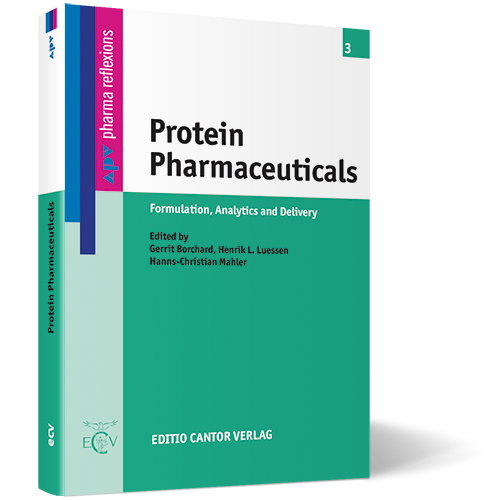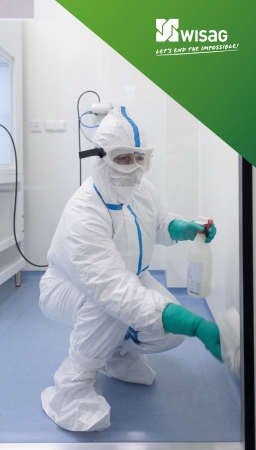-
Protein Pharmaceuticals
Immer mehr „Biopharmazeutika“ – in der Mehrzahl Arzneistoffe auf Proteinbasis – werden entwickelt und gelangen zur Marktreife. Renommierte Autoren aus Hochschule und Industrie beleuchten aus unterschiedlichen Perspektiven diese aktuelle Thematik der Arzneistoffentwicklung auf Proteinbasis mit all ihren Möglichkeiten und Herausforderungen.
Das Buch vermittelt wertvolles Insiderwissen von der Proteinchemie zur Pharmakokinetik/Pharmakodynamik, von der Analytik zur Verpackung sowie von der Formulierung bis hin zu zulassungsrelevanten Fragen. Dabei wurde als wichtigstes Ziel, die praktische Relevanz nicht aus den Augen gelassen was durch die praktische Erfahrung aller Autoren gewährleistet wird, die in den verschiedenen Bereichen der Entwicklung von Proteinpharmazeutika involviert sind.Section I: Protein Characterization and Implications for Protein Formulation Research
.... I Protein Characterization and Implications for Protein Formulation Research Chapter 1 Introduction to Protein Chemistry Carol Kirchhoff 18 ____ Section I There is an increasing drive for ...
.... Kirchhoff 18 ____ Section I There is an increasing drive for the pharmaceutical industry to develop protein therapeutics as the understanding of particular disease states becomes more apparent. The ...
.... therapeutics as the understanding of particular disease states becomes more apparent. The biotechnology needed to produce, isolate, purify, concentrate, formulate and stabilize this latest class of pharmaceuticals is as ...
.... In this chapter, the basic makeup of proteins from their building blocks (amino acids) to quaternary structures will be introduced. Also, degradation pathways will be discussed; subsequent chapters will ...
.... be introduced. Also, degradation pathways will be discussed; subsequent chapters will go in depth into the various aspects of formulation development, analytics, regulatory issues and special considerations. In addition, ...Insgesamt 1901 Fundstellen in 1193 Textabschnitten
Section II: Formulation Development and Drug Delivery of Protein Products
.... Mekking 144 ____ Section II 1. Introduction A goal of early-stage biopharmaceutical development is to quickly move an investigational new drug (IND) into the clinic where it can be ...
.... clinic where it can be tested as a potential therapeutic product. Later-stage development aims to be able to reproducibly manufacture sufficient amounts of therapeutic protein drug substance and product ...
.... use in the marketplace at sufficient quality and at acceptable costs of goods (CoGs). To realize these goals significant and interdisciplinary efforts must be taken from conception in discovery ...
.... realize these goals significant and interdisciplinary efforts must be taken from conception in discovery to upstream, downstream, and formulation development. Much of these efforts are focused on the generation ...
.... formulation development. Much of these efforts are focused on the generation of analytical data to help support optimization of yield, purification, and stability of the molecule and drug product. ...Insgesamt 2609 Fundstellen in 1624 Textabschnitten
Section III: Special Considerations for Protein Formulations
.... on the original immunological definition, the term “immunogenicity” describes the property of a molecule to provoke an immune response upon contact with cells of the immune system. Such an ...
.... Such an immune response may be unspecific, such as the secretion of chemokines or cytokines or acute phase proteins, mainly accomplished by activated cells of the innate branch of ...
.... 2. Recognition of therapeutic proteins triggering immunogenicity 2.1 Immune cells A protein therapeutic needs to engage with several types of immune cells before it will eventually give rise to ...
.... protein which enters the body for the first time and which is not homologous to an endogenous protein, are the following: Professional antigen-presenting cells (APC), such as dendritic ...
.... B cells and plasma cells through a mechanism denoted as “breakage of B cell tolerance” (see also section 5 of this chapter). 2.2 T-cell dependent immunogenicity According to the ...Insgesamt 402 Fundstellen in 227 Textabschnitten
Section IV: Advanced Formulation Techniques for Improved Drug Delivery
.... of protein therapeutics was still in its infancy. Therapeutics of non-human origin were prone to elicit adverse immunogenic reactions after parenteral injection and suffered from poor pharmacokinetic profiles. The ...
.... University (NJ, USA) for the solubilization of lipophilic small molecular weight therapeutics [1], appeared to be an applicable technology to mitigate these obstacles for effective therapy using protein therapeutics. ...
.... of protein therapeutics of human origin and of high purity has increased considerably thanks to genetic engineering, with the biotech/biopharmaceutical industry being a major player in modern drug development ...
.... now including also nucleic acidbased therapeutics, and in the life-cycle management of existing therapeutics. Today, various PEG-conjugated molecules have been approved for therapeutic use in humans or are in ...
.... the development pipeline, and various approaches for pegylation exist or are under development [5]. However, clinical reports of the development of anti-PEG antibodies observed in patients treated with pegylated ...Insgesamt 1607 Fundstellen in 1100 Textabschnitten
Section V: Regulatory Issues of Parenteral Protein Formulations
.... V Regulatory Issues of Parenteral Protein Formulations Chapter 16 Registration of Biotechnology Products Carina E. A. ...
.... indicates, is the product of interaction between the science of biology and technology. The history of modern pharmaceutical biotechnology dates back to the 1970’s with the discovery of the ...
.... back to the 1970’s with the discovery of the first restriction enzymes, allowing researchers to insert foreign genes into bacteria, at which time recombinant DNA technology was born. The ...
.... into bacteria, at which time recombinant DNA technology was born. The first biotech product to make it to the US market was recombinant human insulin (Humulin, Eli Lilly) in ...
.... systems have been designed for expression of human gene products, ranging from yeast cells, to insect cells up to plant- and mammalian cells. Pharmaceutical biotechnology today has delivered many ...Insgesamt 391 Fundstellen in 254 Textabschnitten





